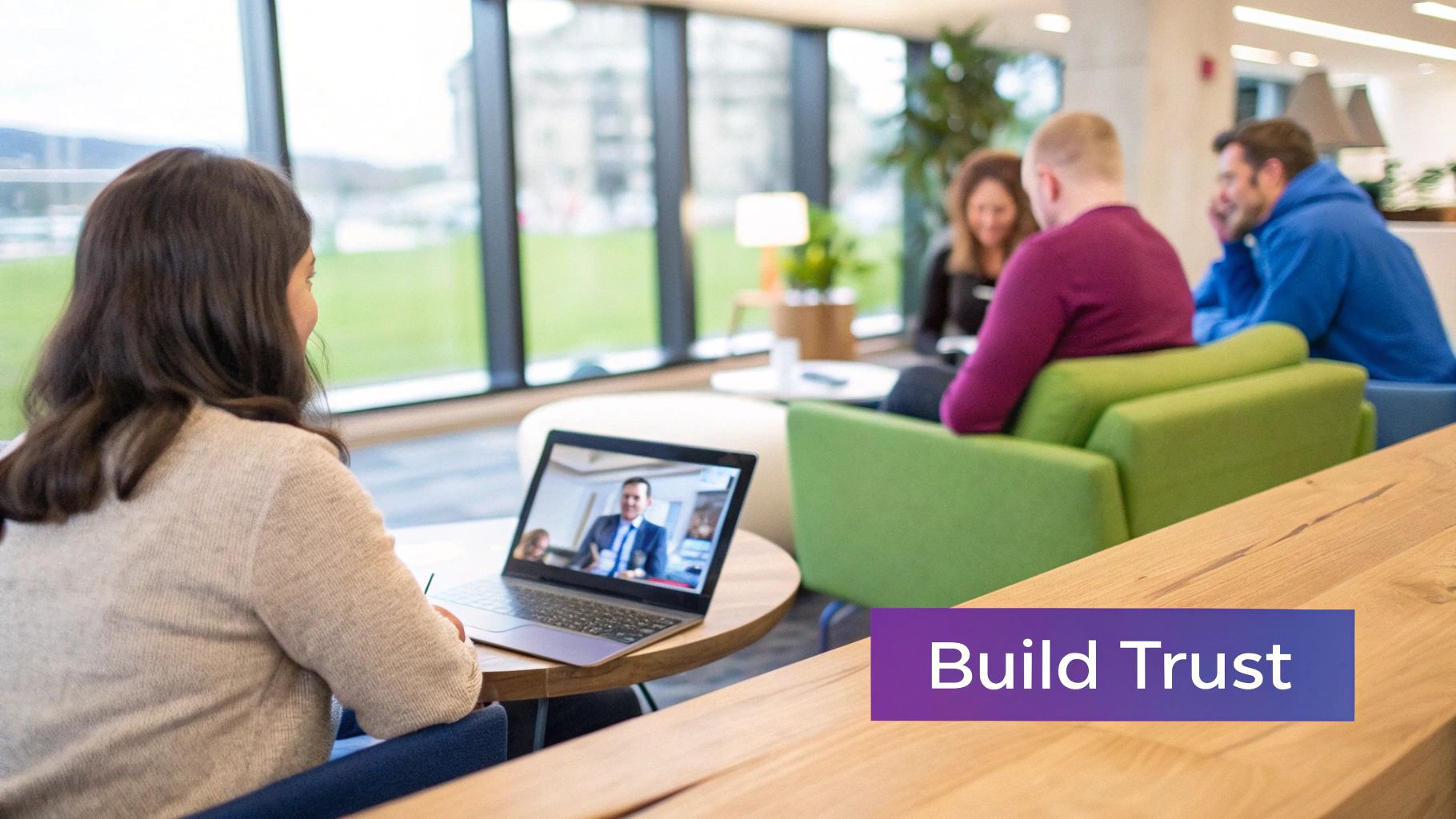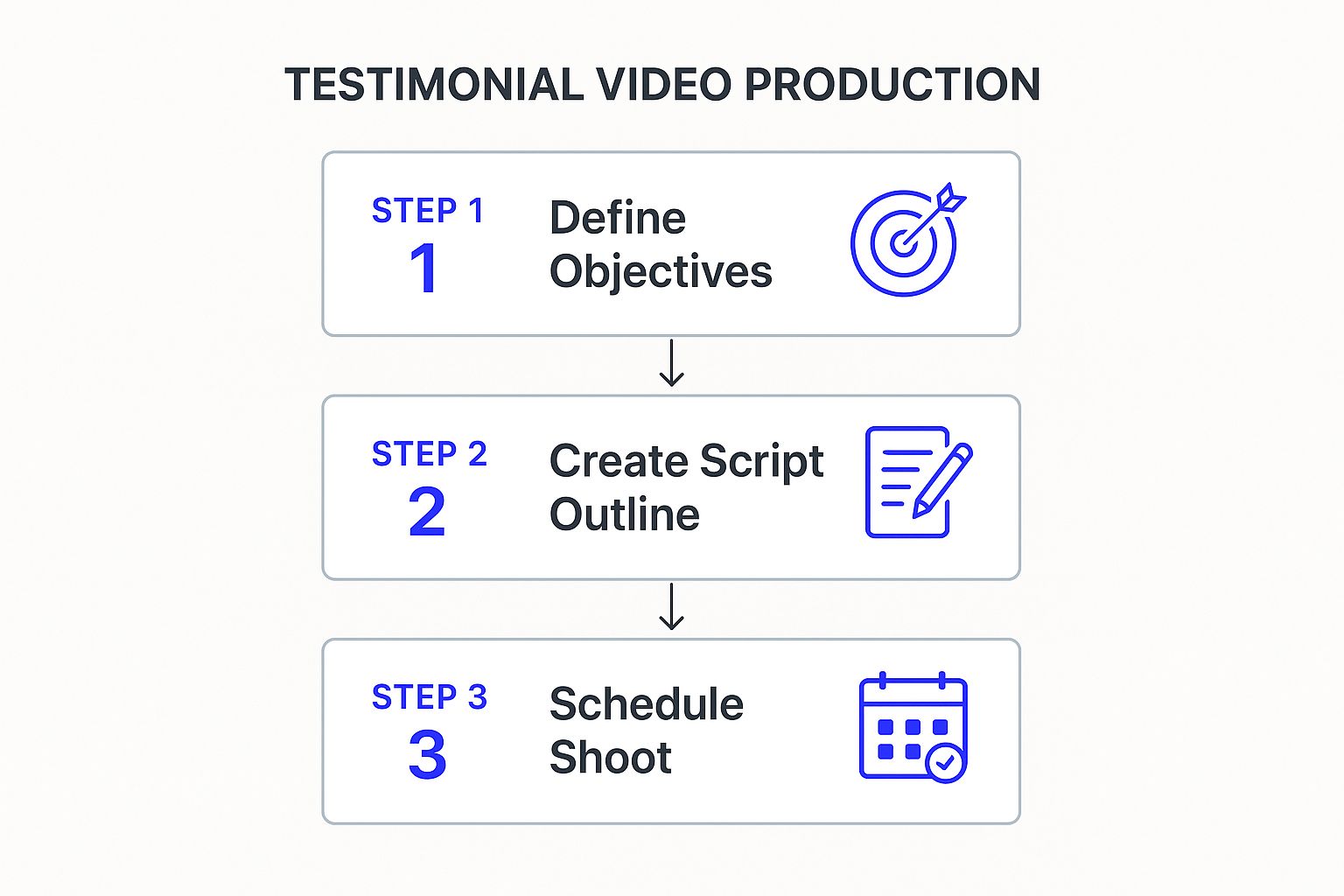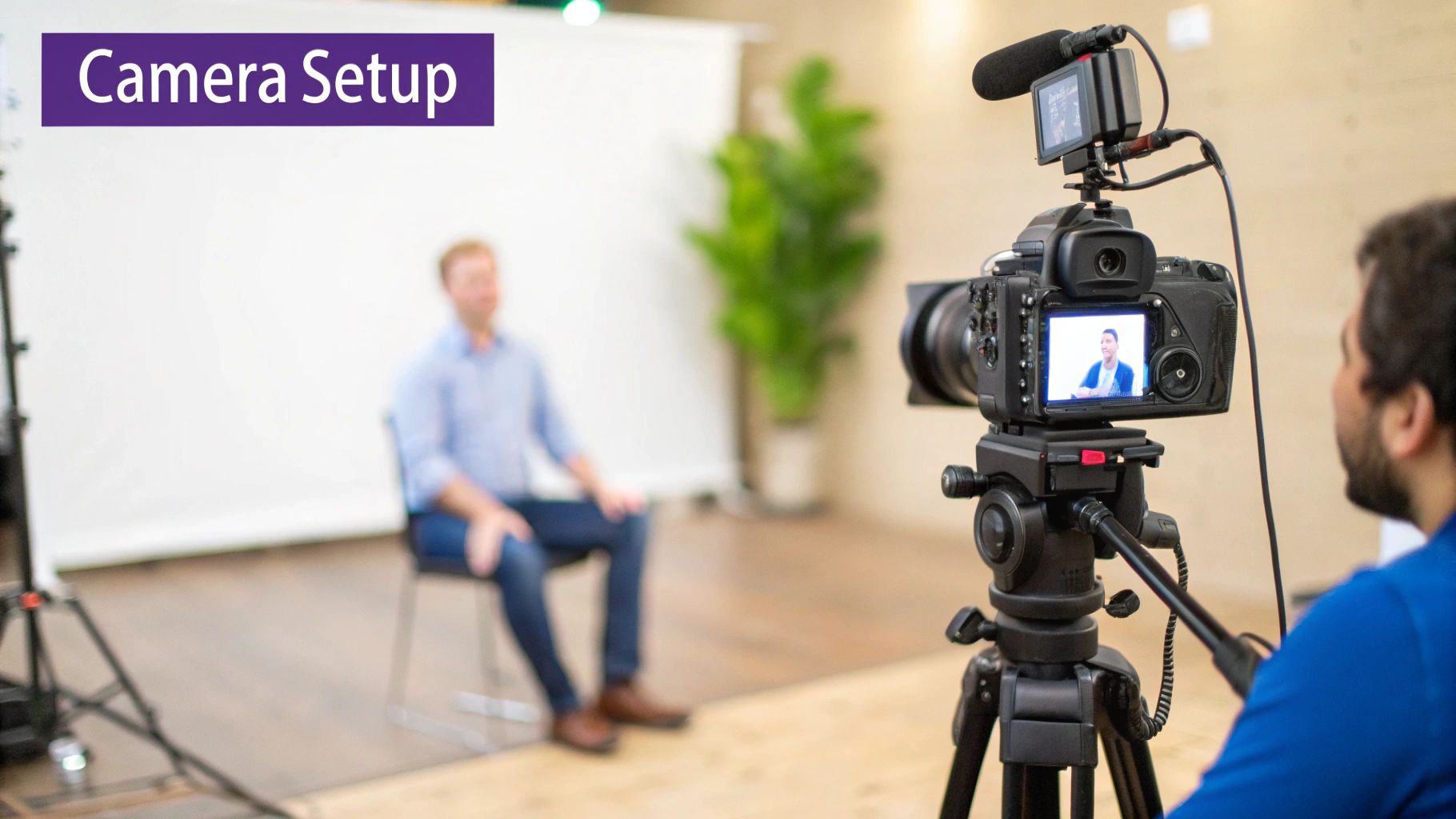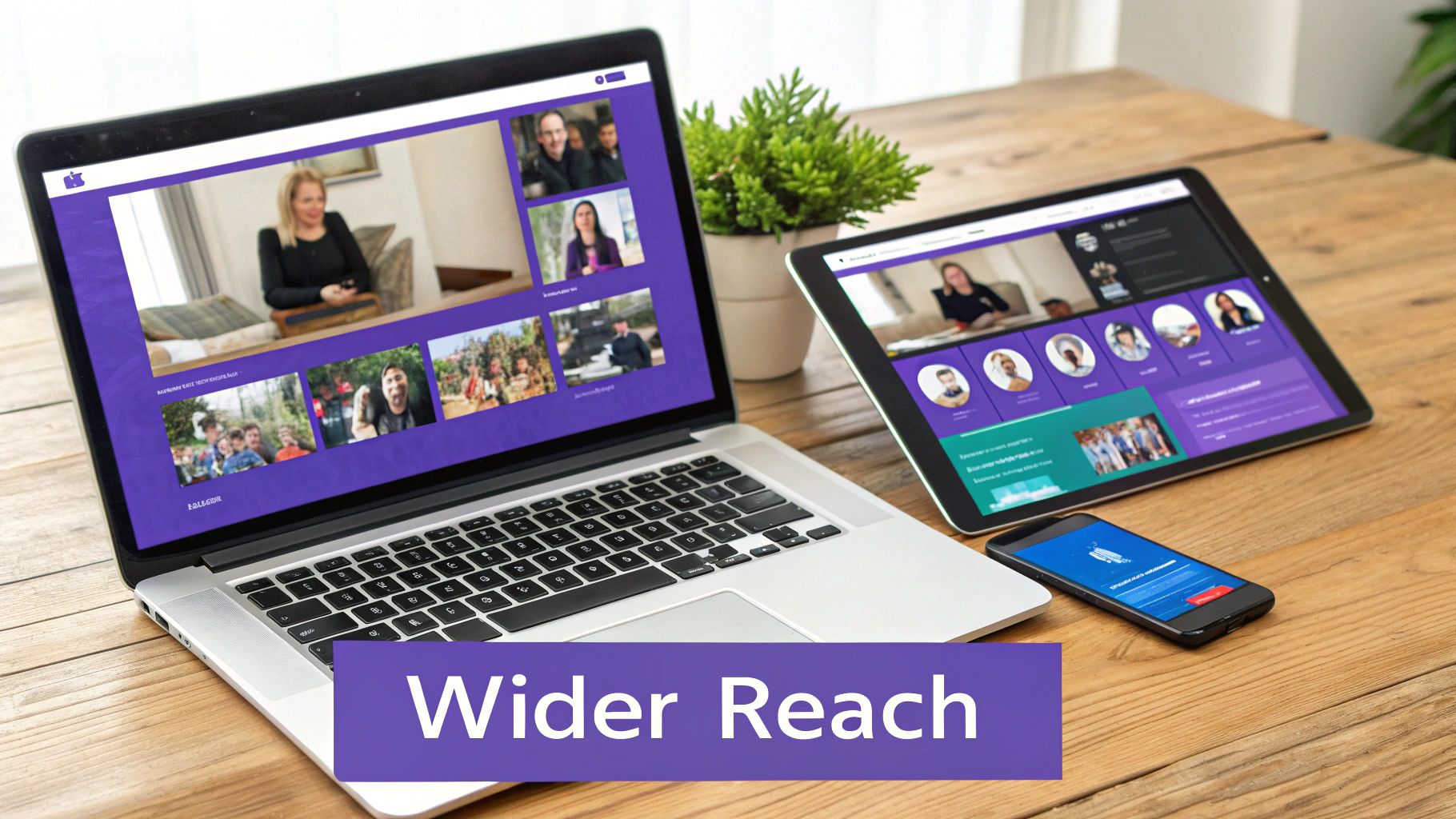Expert Testimonial Video Production Tips to Boost Your Brand
Learn essential testimonial video production strategies to create authentic videos that engage audiences and drive growth. Start your project today!
Posted by
When you boil it down, testimonial video production is all about turning your happiest customers into your best marketers. You’re not just collecting a quote; you’re capturing their genuine story on camera, showing the world how they feel about your brand, product, or service.
These authentic endorsements don’t just build trust—they obliterate the skepticism that most traditional advertising creates.
Why Authentic Customer Stories Are Your Secret Weapon
Let's be honest, we're all swimming in a sea of polished ad copy and slick commercials. Because of that, people are desperate for something real. They’re looking for genuine human experiences to guide their decisions, and nothing delivers that better than an actual person sharing their story on video.
This is where testimonial videos shine. They cut right through the marketing noise and build an immediate, direct line of trust with your audience.
Think about it. When a potential customer sees someone just like them—not a paid actor—talking about the relief, excitement, or success they found with your solution, it creates an instant connection. It's relatable. It's proof that you solved a real person's problem. That kind of social proof is pure gold.
Building Unshakable Brand Trust
Trust is the foundation of every single successful business relationship. Period. Authentic video testimonials act as powerful trust signals, proving you actually deliver on your promises. If you want to create content that really hits home, it's crucial to understand the basics of how to build trust with your audience through video.
The results speak for themselves. An incredible 72% of customers say they trust a brand more after watching positive video testimonials. This huge spike in trust is a big reason why over 91% of businesses now weave video into their marketing efforts.
A powerful testimonial doesn't just sell a product; it sells confidence. It tells prospective customers, "This worked for someone like me, and it can work for you, too."
Of course, all of this effort has a clear goal: getting people to take action. This is another area where testimonial videos are absolute game-changers, guiding prospects from just looking to actually buying.
They tackle potential objections and doubts head-on, all through the customer's own words. It's a natural, compelling way to demonstrate your value without coming across as pushy.
By showing off real-world success stories, you’re providing the tangible proof that often gives a potential buyer that final nudge they need. Weaving these stories into your marketing isn't just a tactic; it's a core component of a winning testimonial marketing strategy that turns happy customers into real, measurable growth.
Integrating video testimonials is a proven method for enhancing credibility and driving conversions. Here’s a quick look at the core benefits.
Core Benefits of Testimonial Video Production
| Benefit | Impact on Business | Key Statistic |
|---|---|---|
| Builds Unshakeable Trust | Creates a strong, authentic connection with potential customers. | 72% of customers trust a brand more after watching video testimonials. |
| Drives Higher Conversions | Provides social proof that nudges prospects to make a purchase. | Videos on landing pages can increase conversions by over 80%. |
| Increases Engagement | Captures attention far more effectively than text-based reviews. | Viewers retain 95% of a message when they watch it in a video. |
| Boosts SEO & Traffic | Video content is favored by search engines, improving visibility. | Websites with video are 53x more likely to rank on Google's first page. |
Ultimately, these benefits compound, creating a powerful feedback loop where customer success fuels new business growth. It's a strategy that pays dividends long after the video is published.
Finding and Preparing Your Best Advocates

Let’s get one thing straight. A powerful testimonial video isn't just about finding a happy customer. It's about finding the right customer with the right story—one that speaks directly to the fears and objections of your ideal clients. A truly great testimonial video production process starts long before the cameras roll.
Your best advocates are probably hiding in plain sight. They’re the ones who consistently drop positive reviews, light up your social media comments, or even send you a random, unsolicited email just to say how much they love your product. These are your champions, and they almost always have a great story to tell.
Start digging. Look through your customer support tickets for those moments when your team turned a frustrating problem into a brilliant save. Sift through your CRM to find long-term clients who have seen real, measurable growth with your help. These are the people who can talk about a genuine transformation, and that's the beating heart of a compelling testimonial.
Identifying Your Ideal Storytellers
Not every happy customer is cut out for the camera. The real magic happens when you find someone whose journey mirrors the one your prospects are currently on. You’re hunting for relatability and a story with a clear beginning, middle, and end.
Think about these archetypes:
- The Skeptic-Turned-Believer: This person was full of doubts but was completely won over by the results. Their story is gold for overcoming sales objections.
- The Power User: They know your product inside and out. They can speak with genuine authority and passion about specific features and how they use them.
- The ROI Champion: This is the client who can hit you with the hard numbers—concrete data on how your solution directly impacted their bottom line.
Once you’ve got a shortlist, the next step is reaching out. And how you ask matters. You want it to feel like a genuine opportunity, not a marketing chore.
Crafting Your Outreach and Shaping the Narrative
Your first message needs to be personal and appreciative. Don't send a generic, templated email. Frame the request as a chance for them to share their success and be positioned as an expert in their field.
"Hi [Name], I was so thrilled to read your feedback about [specific achievement]. We're looking for standout partners like you to feature in a short success story video. It would be a great way to showcase the amazing work you're doing."
This approach respects their time and makes the video a win-win—a collaborative project that benefits them, too. It’s no secret that video is king. In fact, roughly 87% of businesses now use video testimonials in their marketing, which is a 21% jump in just two years. Your outreach can tap into this by offering your customer a professionally produced asset they can share on their own channels.
Once they’re on board, your job is to guide their story without putting words in their mouth. Help them structure their narrative around three core elements:
- The Problem: What specific challenge were they wrestling with before they found you? Get specific.
- The Solution: How, exactly, did they use your product or service to tackle that challenge?
- The Transformation: What does life look like now? What are the measurable results and the emotional benefits?
This simple framework helps keep their story authentic while giving it the structure it needs for maximum impact. By preparing your advocates this thoughtfully, you’re setting the stage for a smooth, successful, and powerful shoot.
For a deeper dive into the entire process, check out our complete guide to video testimonial production.
Choosing the Right Gear for Your Shoot
Let's get one thing straight: you don't need a Hollywood-level camera package to produce a testimonial video that looks and sounds incredible. High-quality gear is more accessible than ever, and frankly, technique trumps budget every single time. The real secret is knowing where to put your money first.
Forget about the camera for a second. The single most important element of your video is crystal-clear audio. It's non-negotiable. Viewers have a surprising tolerance for video that isn't perfectly sharp, but they will bounce immediately if the audio is muffled, staticky, or just plain hard to understand. Your first priority has to be a dedicated microphone.
A new smartphone can shoot stunning 4K video, but its built-in mic is a major weakness. It’s designed to pick up sound from all directions, which is the last thing you want for a focused interview. A simple and affordable lapel mic (also called a lavalier) that clips onto your customer’s shirt is a game-changer. It isolates their voice, cutting out background noise and making them sound crisp and professional.
Upgrading Your Camera and Lighting
Okay, once you've sorted out your audio, then you can think about the visuals. Using a DSLR or mirrorless camera gives you more manual control, especially over depth of field—that's what creates the nice, blurry background that makes your subject pop. But don't feel like you have to run out and buy one. Most modern smartphones have a "Portrait" or "Cinematic" mode that does a surprisingly good job of faking this effect.
Lighting is your next area of focus, and again, you don't need a complicated, expensive kit. There's a reason the three-point lighting setup is an industry standard: it just works.
- Key Light: This is your main, brightest light source, positioned slightly to one side of the camera.
- Fill Light: A softer, less intense light placed on the opposite side to fill in any harsh shadows on your subject's face.
- Backlight: A light placed behind your subject (out of the frame, of course) to create a subtle glow around their hair and shoulders, separating them from the background.
You can pull this off without spending a dime. Use a big window as your key light, a cheap white foam board from a craft store as a fill light (just prop it up to bounce the window light back), and a simple desk lamp for your backlight. It’s all about being resourceful.
As you map out your testimonial video plan, it's also worth looking into the software that can make your life easier. From remote recording platforms to slick editing apps, there are tons of options out there. This list of 20 essential tools for leveraging video testimonials is a fantastic starting point to see what's available.
The graphic below shows how these gear choices fit into the bigger picture of your production workflow.

Notice how defining your goals and outlining the story comes before you even think about cameras or mics. This is crucial. Your gear should serve the story, not the other way around. At the end of the day, the "best" equipment is whatever allows you to capture your customer's story authentically and powerfully.
How to Conduct a Natural Interview

The shoot day is here. This is where all that prep work really pays off. Your main job isn’t to be a director—it’s to make your customer the star of the show and help them completely forget the camera is even there.
This isn’t a formal, stiff interrogation. You’re aiming for a relaxed, genuine conversation. Think of yourself as part interviewer, part host. Start the session with some casual, off-topic chat. Ask them about their day, a recent project they’re excited about, or even the traffic on the way over. This simple warm-up helps dissolve any on-camera nerves and eases them into the real interview.
The more comfortable they feel, the more authentic and heartfelt their story will be.
Asking Questions That Unlock Stories
The absolute key to a great testimonial is detail. You won’t get it with questions that can be answered with a simple "yes" or "no." Your script should be built around open-ended questions that practically beg for a story.
Instead of asking, "Were you happy with the results?" try a more powerful prompt.
"Walk me through the moment you realized our solution was actually working. What did that feel like?"
See the difference? This kind of question invites your customer to relive an experience, which is where the most compelling soundbites are born. It shifts their mindset from answering a question to telling their story.
Here are a few more examples of powerful, open-ended questions I’ve seen work wonders:
- "Can you describe what life was like before you started working with us? What was the single biggest frustration you faced?"
- "Tell me about a specific time our product saved you from a major headache."
- "What was the most unexpected benefit you've experienced since we started working together?"
- "If you were recommending us to a colleague, what's the very first thing you would tell them?"
Listen intently to what they're saying. Be ready to ask follow-up questions. If they mention something interesting, gently probe for more detail with a simple, "Oh, that's interesting, can you tell me more about that?" Sometimes the best moments are completely unscripted.
Capturing Compelling B-Roll Footage
Let’s be honest: a video that’s just a "talking head" can feel static and lose a viewer's attention fast. This is where B-roll saves the day.
B-roll is any supplemental footage you capture that isn't the main interview. It’s the visual spice that brings the story to life. The goal of your B-roll is to show what the customer is telling.
This footage transforms a simple interview into a dynamic narrative. While your customer talks about productivity gains, you can cut to shots of them confidently using your software at their desk. If they mention their team's improved collaboration, show footage of them actually interacting with colleagues. It makes everything feel so much more real.
Plan your B-roll shots ahead of time. Think about the key themes in their story and what visuals would best reinforce those points.
Examples of Effective B-Roll:
- Shots of the customer in their natural work environment—at their desk, in a meeting, etc.
- Close-ups of their hands typing or using your product on a screen.
- Footage of them interacting with their own customers or team members.
- Shots of the physical results of their work, like a finished project or a happy client.
Capturing strong B-roll is a critical part of the testimonial video production process. It adds a layer of professionalism and visual interest that elevates the entire video, making the story more engaging and memorable for your audience. It’s a non-negotiable step for creating content that truly performs.
Editing Your Footage into a Compelling Story
This is where the raw material becomes something special. The editing suite—whether it's a high-end program or a simple app—is where you transform hours of footage into a tight, emotionally resonant story that grabs attention. It’s a process of careful selection, creative assembly, and a bit of magic.
Your first job is to sift through the interview footage and hunt for the gold. Listen for the moments where your customer’s emotion really shines through, where they articulate their pain point perfectly, or when their voice cracks with genuine excitement describing the transformation. These are the golden nuggets, the very foundation of your video’s narrative.
Here’s a structure that works almost every time: hook the viewer immediately. Don't waste precious seconds on a slow intro. Start the video with the single most impactful quote from the entire interview—a powerful statement about the results they got or the problem you solved.
Weaving in B-Roll and Visuals
Once you've mapped out your core story using the best interview clips, it's time to bring it to life visually. The rule is simple: show, don’t just tell.
When your customer talks about feeling overwhelmed by their old process, cut to a shot of them looking stressed at their desk. When they rave about newfound efficiency, show them confidently using your product. It’s that simple.
This interplay between the interview (the "telling") and the B-roll (the "showing") is what elevates a basic video into a compelling story. It makes the entire thing more dynamic and reinforces the key messages, holding the viewer's attention far longer than a static talking-head shot ever could.
Adding Professional Polish
The final layers of the edit are what give your video that on-brand, professional feel. This is where you add subtle background music to underscore the emotion, create clean text overlays to emphasize key points, and pop in branded graphics like your company logo or a lower third with the customer's name and title.
A word of caution on music: choose a track that complements the mood, but make sure it never overpowers the customer's voice. Their story is the hero; the music is just the supporting cast.
Making these edits can feel intimidating, but the right tools make a world of difference. To help you choose the right tools for post-production, you can explore the best video editing software for social media, which breaks down options for every skill level.
This level of polish signals quality and reinforces your brand's credibility. In fact, 44% of marketers spend over $15,000 on a single testimonial when outsourcing to an agency, with some budgets hitting $50,000 for premium content. You don't need a budget that big, but the principle is the same: the final edit shapes perception.
Ultimately, editing is storytelling. By carefully selecting your clips, weaving in visual context with B-roll, and adding a layer of professional polish, you’re turning raw footage into a powerful asset that authentically reflects your brand and resonates deeply with your audience.
Answering Your Top Questions About Testimonial Videos

As you start producing testimonial videos, you’ll quickly find a few common questions pop up almost every single time. Knowing how to handle these ahead of time can be the difference between a project that flows smoothly and one that feels like a constant struggle.
Let's walk through the most frequent challenges I see and how to tackle them with confidence.
How Long Should a Testimonial Video Be?
The sweet spot for a great testimonial video is between 1 and 3 minutes. That’s just enough time to tell a compelling story—the before, the after, and the real transformation—without losing your viewer's attention. Anything longer and you start seeing a significant drop-off, especially on crowded social feeds.
For social media, you have to think even shorter. Your best bet is to create high-impact, bite-sized versions that are 30-60 seconds long. These are perfect for Instagram Reels, TikTok, or paid ads where you have only a few seconds to grab someone. The goal is always to get the core message across and make it stick.
What if My Customer Is Nervous on Camera?
First off, this is completely normal. Most people aren't professional actors, so a camera in their face can feel incredibly intimidating. Your most important job here isn't as a director, but as someone who can make them feel comfortable and at ease.
My advice? Frame the entire thing as a casual chat, not a formal interview. I always start by asking easy, off-topic questions just to build some rapport and get them talking. Reassure them that mistakes are totally fine—that’s what editing is for! It takes the pressure off, and you’ll find their genuine personality starts to come through.
The most authentic testimonials come from genuine conversations, not perfect performances. Your ability to create a relaxed atmosphere is just as important as your camera skills.
Honestly, a little bit of nervousness can even feel more authentic and relatable to the viewer. If you need some ideas for questions that get the conversation flowing, our guide on how to write a testimonial has some fantastic prompts you can easily adapt for a video interview.
Should I Pay Customers for Testimonials?
In a word: no. It's best to steer clear of directly paying someone for a testimonial. The moment money changes hands, you risk compromising the very authenticity that makes these videos so effective. Viewers have a sixth sense for endorsements that don't feel genuine, and it can completely backfire.
Instead, find other ways to show your appreciation. A thoughtful, non-monetary gesture acknowledges their time and effort while keeping the integrity of their story intact.
Here are a few things that have worked well for us:
- A gift card to a local coffee shop or their favorite restaurant.
- A significant discount on their next purchase or subscription renewal.
- A swag bag with some cool branded merch or free products.
- Featuring their business with a logo and a link back to their site in the video.
Can I Create a Great Testimonial Video Remotely?
Absolutely! High-quality remote testimonials are more accessible than ever, and they’re a brilliant, cost-effective way to gather content without the hassle of an on-site shoot. There are great platforms out there that can capture fantastic video and audio right from your customer's laptop or phone.
To get the best results, just give your customer a simple prep guide. Here are the three non-negotiables:
- Lighting: Have them sit facing a window. Natural light is your best friend.
- Audio: A simple headset with a built-in mic makes a world of difference for clear sound.
- Background: Ask them to find a quiet spot with a clean, uncluttered background.
With just a little guidance, you can collect powerful, professional-looking testimonials from happy customers all over the world.
Ready to streamline your entire testimonial collection process, from video requests to social media sharing? EndorseFlow gives you all the tools you need to gather authentic customer stories and turn them into powerful marketing assets. Start your 14-day free trial today.